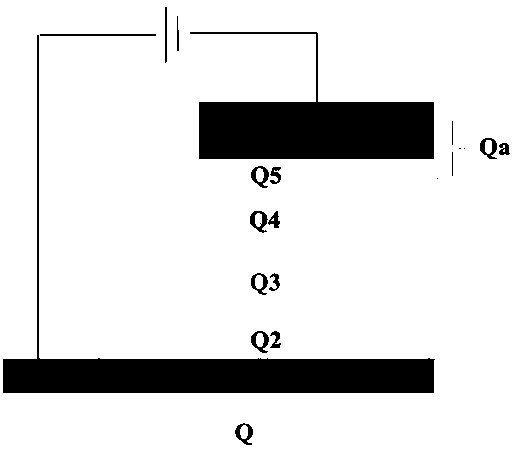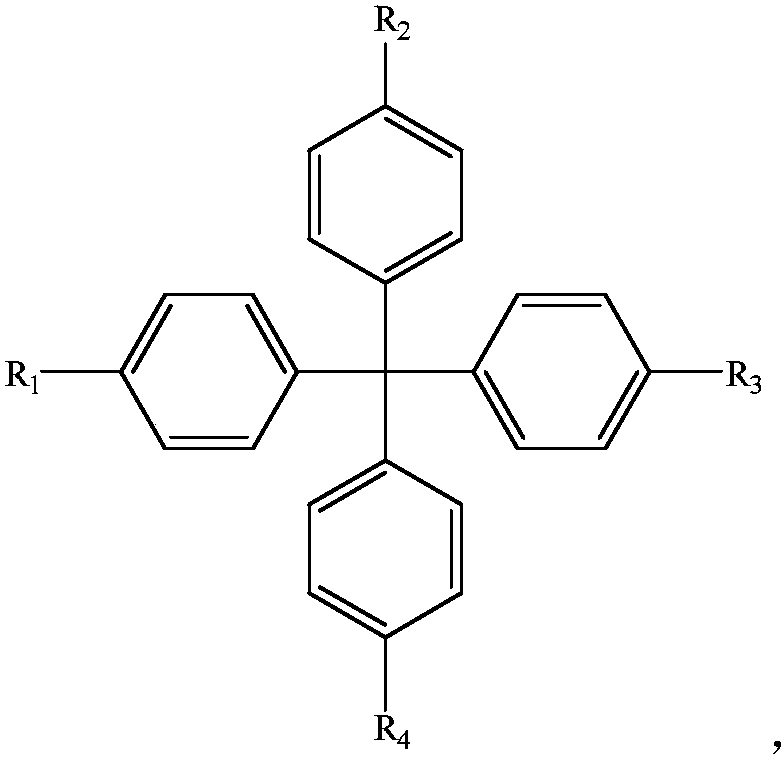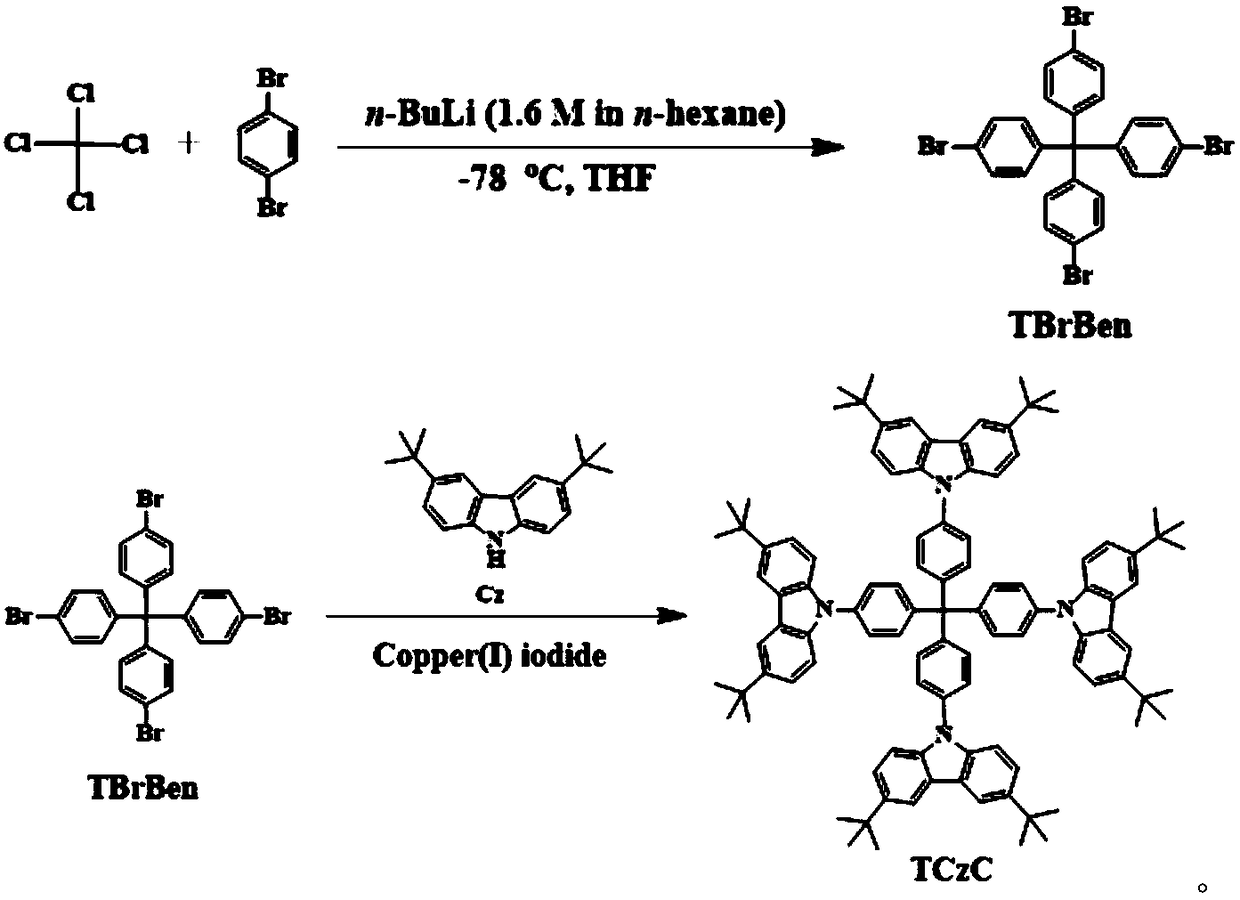Tetraphenyl carbon-based OLED main body material and application thereof in preparation of OLED device
A host material, tetraphenyl carbon technology, which is applied in the fields of electric solid devices, semiconductor devices, organic semiconductor devices, etc., can solve the problems of wide energy band gap and OLED host materials cannot be provided at the same time, so as to improve efficiency and balance Hole and electron transport capability, low cost effect
- Summary
- Abstract
- Description
- Claims
- Application Information
AI Technical Summary
Problems solved by technology
Method used
Image
Examples
Embodiment 1
[0023] The structural formula is Synthesis of the first target compound:
[0024] Add n-butyllithium n-hexane solution (6.6mL, 10.5mmol) dropwise to a solution containing 1,4-dibromobenzene (2.36g, 10mmol) in THF (20mL), at -78°C under the protection of inert gas argon Reaction 1h. Then, carbon tetrachloride (1.05 mL, 5 mmol) was added into the reaction solution and the above conditions were maintained for 2 h, then slowly heated to room temperature 27° C. and stirred for 12 h. Finally, 30 mL of water was added to interrupt the reaction and extraction was performed with chloroform. The obtained organic layer was purified by column chromatography to obtain the intermediate product TBrBen (2.15g, yield 68.5%). The intermediate product is identified and analyzed by a mass spectrometer, and the result is: mass spectrum (EI): m / z C 25 h 16 Br 4 Theoretical value: 635.79; measured value: 635(M) + .
[0025] Cz (2.5g, 8.9mmol), intermediate product TBrBen (1.4g, 2.2mmol), Cu...
Embodiment 2
[0029] The structural formula is Synthesis of the second target compound:
[0030] In this example, the synthesis method of the intermediate product TbrBen is the same as that of Example 1 (the specific synthesis process is omitted).
[0031] Cz (2.5g, 8.9mmol), intermediate product TBrBen (2.8g, 4.5mmol), CuI (0.19g, 1.0mmol) and K 3 PO 4 (1.69g, 8.0mmol) was added into 100mL of toluene, and reacted for 24 hours under the protection of argon and reflux. After removal of the solvent, the residue was extracted three times with dichloromethane (3×100 mL), the organic phases were combined and dried over anhydrous magnesium sulfate, and the residue obtained by concentration was used as eluent with dichloromethane:n-hexane (7:3) on a column The product DCzCBr was purified by chromatography (2.7g, yield 50.3%). The intermediate product is identified and analyzed by a mass spectrometer, and the result is: mass spectrometry (MALDI-TOF): m / zC 65 h 64 Br 2 N 2 Theoretical value...
Embodiment 3
[0037] The blue-light organic electroluminescent material FIrpic is doped into the dichlorotoluene solution of the second target compound DCzCTpo (the mass fraction of DczCTpo is 8%), and it is configured into a solution whose total mass concentration (solute includes FIrpic and DCzCTpo) is 15mg / mL . Such as figure 1 As shown, 20 μL of the solution was dropped onto an indium tin oxide glass substrate, and an organic light-emitting layer film was prepared on a desktop homogenizer (KW-4A type) with a rotation speed of 1000 r / min and a spin coating time of 30 s. The thickness of the obtained organic film was measured to be about 50 nm.
PUM
| Property | Measurement | Unit |
|---|---|---|
| thickness | aaaaa | aaaaa |
| current efficiency | aaaaa | aaaaa |
Abstract
Description
Claims
Application Information
 Login to View More
Login to View More - R&D Engineer
- R&D Manager
- IP Professional
- Industry Leading Data Capabilities
- Powerful AI technology
- Patent DNA Extraction
Browse by: Latest US Patents, China's latest patents, Technical Efficacy Thesaurus, Application Domain, Technology Topic, Popular Technical Reports.
© 2024 PatSnap. All rights reserved.Legal|Privacy policy|Modern Slavery Act Transparency Statement|Sitemap|About US| Contact US: help@patsnap.com










